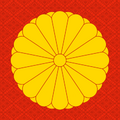Emperor Sushun facts for kids
Quick facts for kids Sushun |
|
|---|---|
| Emperor of Japan | |
| Reign | 588–593 |
| Predecessor | Yōmei |
| Successor | Suiko |
| Born | 520/521 |
| Died | 593 (aged 72) |
| Burial | Kurahashi no oka no e no misasagi (Nara) |
Emperor Sushun (崇峻天皇, Sushun-tennō, d. 592) was the 32nd emperor of Japan, according to the traditional order of succession. His reign started in 587 and ended in 592. Historians consider details about the life of Emperor Sushun to be possibly legendary, but probable. The name Sushun-tennō was created for him posthumously by later generations.
The conventionally accepted names and sequence of the early emperors were not to be confirmed as "traditional" until the reign of Emperor Kammu, who was the 50th monarch of the Yamato dynasty.
Traditional history
Before he became the monarch, this prince's personal name (imina) was Hatsusebe-shinnō, also known as Hatsusebe no Waka-sazaki. His name at birth was Hatsusebe no Miko (長谷部皇子).
Sushun was the twelfth son of Emperor Kimmei. His mother was Oane-no-kimi (小姉君), a daughter of Soga no Iname, who was the chief of the Soga clan.
Sushun had one Empress and two Imperial children.
Events of Sushun's life
- 587: In the 2nd year of Yōmei's reign, he died. The succession was received by a younger half-brother who would become known as Emperor Sushun. This was confirmed in ceremonies.
- 592: Sushun's reign lasted for five years before his death at the age of 72.
The emperor's first minister was his powerful uncle, Soga no Umako. Sushun planned to remove the head of the Soga clan from his office. When the plan was discovered, Umako ordered someone to murder Sushun. In the early history of Japan, this is the second time that an emperor is murdered.
After his death
This emperor's official name after his death (his posthumous name) was regularized many centuries after the lifetime which was ascribed to Sushun.
According to the Imperial Household Agency, the emperor's final resting place is in an earthen tumulus (kofun). Sushun is venerated at a memorial Shinto shrine (misasagi) which is associated with the burial mound.
Related pages
| Preceded by Emperor Yōmei |
Emperor of Japan: Sushun 587-592 |
Succeeded by Empress Suiko |
See also
 In Spanish: Sushun Tennō para niños
In Spanish: Sushun Tennō para niños


